Introduction to Popular Deep Learning Frameworks
Popular Deep learning frameworks are applications, resources, or tools that make it easier and faster to develop deep learning models without having to worry about algorithms. They offer a simple and straightforward method of defining models by utilizing a library of pre-built and optimized components. Rather than writing hundreds of lines of code, we may utilize an appropriate framework to assist us in swiftly creating such a model.
Deep learning is a groundbreaking approach to artificial intelligence that allows computers to learn from their mistakes and comprehend the environment in ways that were previously unimaginable. It has changed the way we use computers, and it is affecting nearly every aspect of our life. It’s difficult to picture the world without deep learning, but it’s much more difficult to predict what it will be like in the coming years.
Characteristics of a Popular Deep Learning Frameworks:
- Optimized for performance
- Easy to understand and code
- Good community support
- Parallelize the processes to reduce computations
- Automatically compute gradients
Let’s take a closer look at the popular deep learning frameworks list.
- Keras
- Tensorflow
- PyTorch
- MXNet
- Sonnet
- Gluon
- ONNX
- DL4J(Deep Learning Framework 4J)
Let’s take a deeper look at the most popular deep learning frameworks:
1. Keras
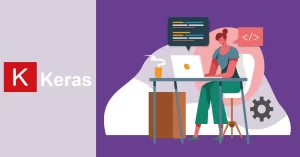
Do you have any experience with Python? If that’s the case, you’ll be able to get in touch with Keras right away. It’s the ideal foundation for you to begin your deep learning adventure.
Keras is a Python library that runs on top of TensorFlow (CNTK and Theano). The TensorFlow interface can be tricky since it is a low-level library, and novice users may struggle to understand some implementations.
Keras, but from the other extreme, is an elevated API designed to allow for quick experimentation. So, if you want speedy results, Keras will handle the fundamental duties and provide the output automatically. Keras supports both Convolutional Neural Networks and Recurrent Neural Networks. It operates smoothly on both CPUs and GPUs. Hence it is one of the most popular deep learning frameworks.
In Keras, models may be divided into two categories:
- Sequential: The model’s layers are defined in a certain order. This indicates that these layers are implemented in order when we train our deep learning model.
- Keras functional API: This is typically used to construct advanced applications, such as multi-output models or shared layer models.
Keras benefits:
- It’s ideal for those who are just getting their feet wet in this sector. It makes learning and prototyping simple ideas straightforward.
- It encourages rapid deep neural network experimentation.
- It aids in the creation of legible and exact code.
What you should know about these popular deep learning frameworks:
- Keras excels at high-level calculations, while low-level computations aren’t its strong strength. Keras employs a distinct library named “backend” for low-level calculations.
- Keras has boundaries when it comes to prototyping. You’ll have to make do with single-line functions if you want to generate huge DL models with Keras. Keras becomes substantially less customizable as a result of this feature making it popular deep learning frameworks.
2. TensorFlow
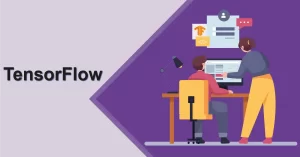
Deep Learning Framework TensorFlow, a Google open-source machine learning and deep learning framework, is likely the most widely used. TensorFlow is a JavaScript-based framework that includes a number of tools and community resources to make training and deploying machine learning and deep learning models as simple as possible. More information on the best deep learning software may be found here.
TensorFlow Lite allows you to deploy models on mobile or embedded devices, while the main tool allows you to construct and deploy models on browsers. TensorFlow Extended is also useful for training, building, and deploying ML/DL models in large production contexts. Hence it is one of the most popular deep learning frameworks.
TensorFlow’s Benefits:
- TensorFlow is the greatest tool for creating Deep Learning models and experimenting with structures.
- It’s being used to do data integration tasks, such as combining graphs, SQL tables, and photos.
What you should know about these popular deep learning frameworks:
- Despite the fact that TensorFlow has experimental interfaces in JavaScript, C++, C#, Java, Go, and Julia, Python remains the most popular programming language for working with TensorFlow. Learn why Python is such a popular programming language among programmers.
- TensorFlow can execute models on mobile platforms, in addition to executing and deploying them on powerful computer clusters (iOS and Android).
- TensorFlow uses a static computing graph and necessitates a lot of code. As a result, you must first define the graph before proceeding with the computations. You will need to re-train the model if the model architecture changes.
3. PyTorch

PyTorch is a Facebook-developed open-source deep learning framework. It was built on top of the Torch library with one goal in mind: to speed up the entire process from research prototype to production deployment. PyTorch is unique in that it features a C++ frontend on top of a Python interface. Hence it is one of the most popular deep learning frameworks.
The “torch.distributed” backend facilitates scalable distributed training and performance optimization in both research and production, while the frontend serves as the foundation for model building.
PyTorch Benefits:
- It’s ideal for training, construction, and deployment of small projects and prototypes.
- Deep Learning applications such as natural language processing and computer vision make heavy use of it.
What you should know about these popular deep learning frameworks:
- Standard training like PDB and PyCharm can be used with PyTorch.
- It uses a constantly updated graph, which allows users to make model architectural modifications throughout the training process.
4. MXNet
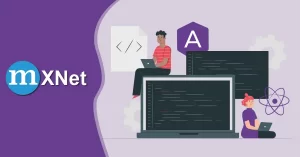
MXNet is a deep learning framework for training and deploying deep neural networks that is open-source. It encourages quick model training since it is very scalable. It supports several programming languages, including C++, Python, Julia, Matlab, JavaScript, Go, R, Scala, Perl, and Wolfram, in addition to a flexible programming architecture. Hence it is one of the most popular deep learning frameworks.
MXNet benefits:
- Multiple GPUs are supported, as well as quick context switching and efficient computing.
- It allows developers to select between imperative and symbolic programming while developing deep learning models.
What you should know about these popular deep learning frameworks:
- MXNet is a transportable network that can scale to numerous GPUs and workstations.
- It’s a lightweight, scalable Deep Learning framework that supports cutting-edge Deep Learning models including convolutional neural networks and long short-term memory networks (LSTMs).
5. Sonnet
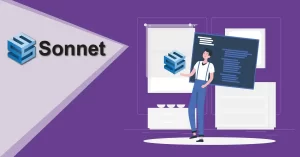
Sonnet is a high-level framework developed by DeepMind for creating complicated neural network architectures in TensorFlow. As you might expect, TensorFlow serves as the foundation for this Deep Learning system. Sonnet is a Python project that tries to design and create the core Python objects that correspond to different parts of a neural network.
These items are then joined to the computational TensorFlow graph in their own right. The method of constructing Python objects separately and attaching them to a graph simplifies the construction of high-level structures. Hence it is one of the most popular deep learning frameworks.
Sonnet benefits:
- Sonnet allows us to create modules that may declare internal submodules or pass to other modules throughout the creation process.
- Because Sonnet was specifically made for TensorFlow, you can readily access its fundamental details, such as Tensors and variable scopes.
- Sonnet models may be used with both raw TF code and high-level libraries.
What you should know about these popular deep learning frameworks:
- Sonnet provides a straightforward yet powerful programming architecture based on a single concept: “snt.Module.” These modules are self-contained and disconnected from one another.
- Although Sonnet comes with a number of established modules, such as snt.Linear, snt.Conv2D, and snt.BatchNorm, as well as some prepared networks of modules (such as snt.nets.MLP), users may also create their own.
6. Gluon
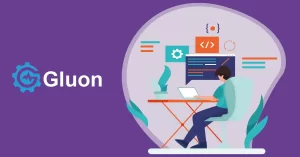
Gluon is an open-source Deep Learning interface that enables developers to construct machine learning models fast and efficiently. It is a relatively new addition to the list of Deep Learning frameworks. It uses a set of pre-built and optimized neural network components to provide a simple and clear API for creating ML/DL models.
Users may define neural networks using Gluon using simple, straightforward, and succinct code. It includes pre-configured layers, optimizers, and initializers, as well as a comprehensive set of plug-and-play neural network construction pieces. Many of the underlying difficult implementation details are eliminated as a result of these. Hence it is one of the most popular deep learning frameworks.
Gluon benefits:
- Gluon is a useful tool for novices who are new to Machine Learning since it allows users to construct and manipulate ML/DL models just like any other data structure.
- It’s simple to prototype and experiment with neural network models because of Gluon’s high flexibility quotient.
What you should know about these popular deep learning frameworks:
- It is built on MXNet and provides a user-friendly API for creating DL models.
- It combines the training method and the neural networks, giving the growth process more flexibility without sacrificing performance. The Gluon trainer technique is the name for this type of training.
- Users can choose a dynamic neural network definition in Gluon, which means they can create it on the fly using any structure and Python’s native control flow.
7. ONNX
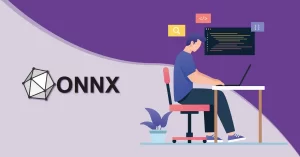
Microsoft and Facebook collaborated on the Open Neural Network Exchange (ONNX) initiative. It’s an open environment for the creation and presentation of machine learning and deep learning models. It offers definitions of built-in operators and standard data types, as well as an extendable computation graph model. ONNX makes it easier to transfer models between multiple AI frameworks – you can train models in one and then move them to another for inference. Hence it is one of the most popular deep learning frameworks.
ONNX Benefits:
- With ONNX, it becomes easier to access hardware optimizations. You can use ONNX-compatible runtimes and libraries that can maximize performance across hardware systems.
- ONNX allows users to develop in their preferred framework with the chosen inference engine, without worrying about downstream inferencing implications.
What you should know about these popular deep learning frameworks:
- ONNX was created as a smart mechanism for transitioning between multiple machine learning frameworks like PyTorch and Caffe2.
- Caffe2, Microsoft Cognitive Toolkit, MXNet, and PyTorch now support ONNX models. There are likewise connectors for a variety of other common libraries and frameworks.
8. DL4J(deep learning)
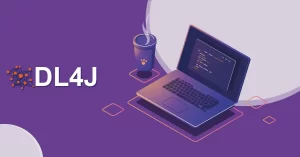
Deeplearning4J (DL4J) is a Java and JVM-based distributed deep learning library (Java Virtual Machine). As a result, any JVM language, such as Scala, Clojure, or Kotlin, may use it. The calculations underlying DL4J are written in C, C++, and Cuda. The platform enables the use of Apache Spark and Hadoop, which speeds up model training and allows AI to be integrated into business contexts via distributed CPUs and GPUs. It can even match Caffe’s performance when using several GPUs. Hence it is one of the most popular deep learning frameworks.
DLJ4 Benefits:
Deep neural networks may be built using DL4J by layering shallow neural nets. Users may mix variational autoencoders, sequence-to-sequence autoencoders, convolutional nets, or recurrent nets as needed in a distributed, production-grade framework that works with Spark and Hadoop.
What you should know about these popular deep learning frameworks:
- It runs on the ND4J numerical computing library, which is open-source.
- Neural networks are trained in parallel using DL4J’s iterative reduction via clusters technique.
- The limited Boltzmann machine, deep belief net, deep autoencoder, recursive neural tensor network, stacking denoising autoencoder, word2vec, doc2vec, and GloVe are all implemented in this library.
Deep Learning Frameworks Popularity
The deep learning frameworks popularity is mentioned below:
- TensorFlow. Google’s open-source platform TensorFlow is perhaps the most popular tool for Machine Learning and Deep Learning.
- PyTorch. PyTorch is an open-source is popular Deep Learning frameworks developed by Facebook.
- Keras.
- Sonnet.
- MXNet.
- Swift for TensorFlow.
- Gluon.
- DL4J.
Deep Learning Frameworks Rankings
The most popular deep learning frameworks ranking is mentioned below:
Conclusion
Briefing up with the most popular Deep Learning Frameworks, now that you have a thorough understanding of all of the main Deep learning frameworks accessible, you can make an educated selection and select the one that best matches your project. The first step in finding the most popular deep learning frameworks is to select the most appropriate deep learning framework for your workload. Deep learning is at a really interesting phase right now, with new frameworks being developed on a regular basis. The deep learning frameworks which are ingrained in the bulk of company activities are gaining traction now and then.
If your company is considering deep learning, have a look at the frameworks on this list to determine which one best suits your needs. Please leave a remark if you have any queries. Thank you for taking the time to read this.
Frequently Asked Question’s
1. What is the most popular deep learning framework?
TensorFlow Ever since it was released, TensorFlow has become the most popular deep learning framework. TensorFlow’s flexible architecture allows you to build custom deep learning models and use its components to develop new machine-learning tools.
2. What are the following popular deep learning frameworks?
The most popular deep learning frameworks are:
- Tensorflow
- Keras
- PyTorch
- MxNet
- Chainer
3. What are frameworks in deep learning?
Popular Deep learning Frameworks offer building blocks for designing, training, and validating deep neural networks through a high-level programming interface.
4. Is Theano a popular deep learning framework?
Theano, a deep learning library, was developed by Yoshua Bengio at Université de Montréal in 2007. It can be run on both CPU and GPU, hence, providing smooth and efficient operation, and is based and written in Python. Theano is pretty famous with academic researchers, due to it being a deep learning library.
5. Is TensorFlow still popular?
TensorFlow is Still More Popular in the Job Market. Community Support of TensorFlow is Uncanny. TensorFlow Offers Many Supporting Technologies. TensorFlow 2.0 is Very Easy to Use.
6. What are some of the difficulties in configuring neural networks?
This is the case because there are no clear guidelines for constructing a network for a given context. Analytically, we can’t figure out which model type or configuration is appropriate for a dataset. A shortcut for establishing a neural network on an issue is to copy the setup of another network for a similar problem. This strategy, however, seldom produces effective results since model settings are not transferable between situations. You’re also likely to work on predictive modeling problems that aren’t covered in the literature.
7. Which popular deep learning frameworks are growing fastest?
The most popular deep learning framework is TensorFlow is both the most in-demand framework and the fastest growing.
8. Does Microsoft use TensorFlow?
Google’s underlying machine learning technology is TensorFlow. Microsoft’s Cognitive Toolkit. Both TensorFlow and Cognitive Toolkit have been released to open source.
9. Does Tesla use PyTorch or TensorFlow?
Tesla utilizes Pytorch for distributed CNN training. For autopilot, Tesla trains around 48 networks that do 1,000 different predictions and it takes 70,000 GPU hours
10. What are the problems with regards to poor performance of a deep learning model?
When it comes to the bad performance of a deep learning neural network model, there are three categories of issues that are simple to diagnose. Learning issues present themselves in a model that is unable to successfully learn a training dataset, or that makes slow progress or performs poorly when training the dataset.
Generalization issues reveal themselves in a model that overfits the dataset and performs poorly on the holdout dataset. Prediction issues reveal themselves in the stochastic training procedure, which has a significant impact on the final model, resulting in a high degree of variability in behavior and performance.
11. How can the variance in the performance of the final model be reduced?
By including bias, the variation in the final model’s performance can be minimized. Combining the predictions from numerous models is the most typical approach to incorporate bias into the final model.
Ensemble learning is the term for this. Ensemble learning can improve predictive performance in addition to reducing the variance of a final model’s performance. Each contributing model must have skill, which means that the models must produce predictions that are better than random, while the prediction errors between the models must have a low correlation.












